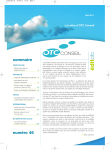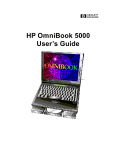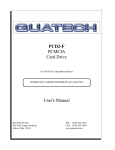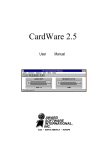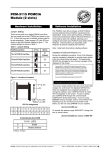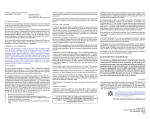Download Epson ActionNote 880C User`s guide
Transcript
EPSON PCMCIA Software User’s Guide Printed on recycled paper with at least 10% post consumer content ® IMPORTANT NOTICE DISCLAIMER OF WARRANTY Epson America makes no representations or warranties, either express or implied, by or with respect to anything in this manual, and shall not be liable for any implied warranties of merchantability and fitness for a particular purpose or for any indirect, special, or consequential damages. Some states do not allow the exclusion of incidental or consequential damages, so this exclusion may not apply to you. COPYRIGHT NOTICE All rights reserved. No part of this publication may be reproduced, stored in a retrieval system, or transmitted, in any form or by any means, electronic, mechanical, photocopying, recording, or otherwise, without the prior written permission of Epson America, Inc. No patent liability is assumed with respect to the use of information contained herein. Nor is any liability assumed for damages resulting from the use of the information contained herein. Further, this publication and features described herein are subject to change without notice. TRADEMARKS EPSON is a registered trademark of Seiko Epson Corporation EPSON Connection and EPSON Direct are service marks of Epson America, Inc. Card Soft, Card Wizard, and Card Lite are trademarks of System Soft Corporation. System Soft is a registered trademark of System Soft Corporation General notice: Other product names used herein are for identification purposes only and may be trademarks of their respective companies. Copyright © 1995 by Epson America, Inc. Torrance, California, USA ii 400442800 4/95 Contents Introduction How to Use This Manual . . . . . . . . . . . . . . . . . ...2 Where to Get Help . . . . . . . . . . 3 CompuServe On-line Support. . . . . .. . . . 4 Chapter 1 Using CardWizard Using CardWizard . . . . . . . . . . . . . . . . . Solving Problems Using AutoCorrect. . . . ... Modifying Resources Manually. . .. .. . Launching Applications. . . .. . . .. . Using the Correct Button for System Conflicts Using Menus to Modify Resources. . .. .. . . . . . . . . ...1-2 . . 1-4 . 1-6 . 1-6 . .. . .1-7 .. . 1-8 Chapter 2 Using CardLife Using the Configuration Utility. . . . . . . . Starting the Configuration Utility. . . . . . . Editing PC Card Configurations. . . . . . . Changing the Card Insertion Parameters. . . . . . Changing the Level of Card Support. . . .. .. Using the CARDINFO Command. . . . . . . . . Commands in the CONFIG.SYSFile. . . ... . . .. . 2-2 2-3 2-3 2-5 2-6 2-8 2-10 Chapter 3 Using CardSoft Using the Configuration Utility. . . .. . .. . . 3-2 Starting the Configuration Utility. .. . . .. . . . 3-2 Editing the PC Card Configurations. . .. . . . . 3-3 Changing the Card Insertion Parameters. ... . . . . 3-6 Modifying the Resource Allocation. . . .. . . .. 3-7 Changing the Display for the Configuration Utility. . .. . . . 3-8 Using the CSALLOC Command. .. . . . .. 3-9 Using the CARDINFO Command .. . .. . . . ... . 3-10 Commands in the CONFIG.SYSFile. . .. . . .. 3-13 iii Index iv Introduction Your EPSON ® PCMCIA TM software makes it easy to configure your computer for PC cards. The software is already installed on your EPSON computer, and offers Plug-and-Play support for both MS-DOS ® and Microsoft ® W i n d o w sTM environments. You simply insert your PC card into the PCMCIA slot and begin using it. You won’t need to configure the computer because the PCMCIA software allocates system resources so that PC cards and your system hardware work together seam lessly. PCMCIA software includes the following utilities: CardWizard, TM which automatically corrects configuration conflicts for you or lets you configure your PC cards using an easy-to-use Windows interface CardLite,TM which supports fax/ modem and LAN cards in the MS-DOS environment in a way that leaves more memory for other applications CardSoft,T Mwhich provides the full range of PCMCIA configuration options for the MS-DOS environment. PCMCIA software supports PC cards from most vendors so when you buy new PC cards for your computer, you’ll know your software will support them. Introduction 1 Note Flash File System (FFS) software is not included with this release of PCMCIA software. If you need support for linear flash cards, contact your flash card manufacturer. EPSON linear flash cards are compatible with PCMCIA software, but require an appropriate Memory Technology driver. Please contact EPSON for this driver. How to Use This Manual You do not need to read everything in this book. Since EPSON has already pre-installed the PCMCIA software, you probably won’t need to change any settings. Just insert your PC card and you‘re ready to go. If you want to customize your system’s configuration, see the following summary to find the chapters you may need to read. Chapter 1 describes how to use CardWizard. Chapter 2 describes how to use the CardLite utilities from DOS. Chapter 3 describes how to use the Card Soft utilities from DOS. At the end of this book, you’ll find an Index and a list of internation al marketing locations. 2 Introduction Where to Get Help If you purchased your EPSON product in the United States or Canada, EPSON provides support and service through the EPSON Connection.SM In the United States and Canada, dial (800) 922-8911. Call the EPSON Connection for the following: Technical assistance with the installation, configuration, and operation of EPSON products Assistance in locating your nearest Authorized EPSON Reseller or Customer Care Center Customer relations EPSON technical information library fax service Product literature on current and new products. You can purchase accessories, manuals, or parts for EPSON products from EPSON Accessories at (800) 873-7766 (U.S. sales only). In Canada, call (800) BUY-EPSON for sales locations. When you call for technical assistance, be ready to identify your system and its configuration, and provide any error messages to the support staff. If you purchased your EPSON product outside the United States or Canada, contact your EPSON dealer or the marketing location nearest you for customer support and service. International marketing locations are listed at the end of this manual. If you need help with any other software application program you are using, see the documentation that came with that program for technical support information. Introduction 3 CompuServe On-line Support Your EPSON computer includes the CompuServe® WinCIM information manager and a free CompuServe membership. This membership entitles you to a $15 usage credit on Compu Serve’s extended services and forums. The brochure that came with your computer describes the CompuServe services and how to access them, and also provides subscription information. Note To access CompuServe, you must use a modem. If your ActionNote did not come with a modem, you can install an internal modem, an external modem, or a modem PC card. If you have a modem, the fastest way to access helpful tips, specifications, drivers, application notes, tables for DIP switch or jumper settings, and bulletins for EPSON products is through the Epson America Forum on CompuServe. If you are already a CompuServe member, simply type GO EPSON at the menu prompt to reach the Epson America Forum. 4 Introduction Chapter 1 Using CardWizard Card Wizard is a user-friendly Windows interface for Card Soft that can automatically reconfigure resources for your PC cards. Specifically, CardWizard performs these tasks: ❑ Provides automatic detection and correction of PC card configuration problems ❑ Lets you set up your system to start a program automatically when you insert a card ❑ Displays detailed information about installed cards, including status, assigned system resources, vendor name, and card type ❑ Reconfigures PC cards and manages system resources, such as I/O ports, IRQs, and memory ❑ Notifies you of any status changes for the PC cards in your system. CardWizard is a standard Windows application and uses Windows techniques for selecting icons and for moving and sizing windows. This chapter assumes that you are familiar with these techniques. If you need help while using CardWizard, you can use CardWizard’s on-line help. Just select Help (or press F1), a n d select Contents from the Help pull-down menu. Then select the topic you want from the contents list. This chapter describes how to start CardWizard, how you can tell if your computer recognizes the card, and how to use CardWizard to solve typical configuration problems. Using CardWizad 1-1 Using CardWizard Every time you start Windows, it loads the CardWizard drivers. If a PC card is inserted, your computer beeps to notify you of the card status. If your system beeps twice, it recognizes the card you inserted and identifies the card on the icon. If your system beeps once and you see a message, CardWizard has not been able to recognize the card or the card is unconfigured; see the next section. To start Card Wizard, double click on the Card Wizard icon in the System Soft Tools program group located in the Windows Program Manager, as shown below. Note To start CardWizard, the CONFIG.SYS file must load the Card Soft drivers. You can also start Card Wizard automatically every time you open Windows by copying the CardWizard icon to the Windows Startup Program group. See your Windows documentation for more information. 1-2 Using CardWizad After you start CardWizard, you see the introductory banner, and then the following Card Information window. From the Card Information window, you can use pull-down menus to correct system conflicts, view system resources, modify configuration settings, and customize CardWizard for your system, as described in the following sections. Using CardWizad 1-3 Solving Problems Using AutoCorrect When the PC card you insert results in a configuration conflict, you see the following notification screen: Follow these steps to use the Auto Correct feature. 1. Select OK. CardWizard displays a Card Information screen. A question mark (?) indicates a problem in a particular slot, and a warning message describes the problem, as shown below: 1-4 Using CardWizad 2. Select Wizard on this screen to see more information about the problem, as shown below: 3. Select AutoCorrect to have CardWizard reassign resources to resolve the problem. CardWizard displays the message AUTO CORRECTION IN PROGRESS in the Wizard Information screen. After Card Wizard has resolved the problem, it m ay prompt you to restart Windows or reboot your system to initiate the changes. If AutoCorrect cannot resolve the problem, it displays additional options (in the Wizard Information screen) for you to try. Using CardWizad 1-5 Modifying Resources Manually CardWizard allows you to manually correct resource conflicts using the Correct button on the Wizard Information screen. It also provides simple pull-down menus for changing system settings, such as launching an application when you insert an associated PC card. The following sections describe how to use these CardWizard features. Launching Applications One of the most popular features CardWizard offers is the ability to set up your computer so that when you insert a PC card, the particular application you need to use with the card starts automatically. For example, you can have your computer start CompuServe or an electronic mail program whenever you insert a fax/ modem card or start a backup utility when you insert an ATA card. Note Card Wizard only starts an application when its associated PC card is configured. To setup your computer to launch an application with an associated PC card, use the Options menu from the Card Inform ation screen. See page 1-11 or the CardWizard on-line help for more information. 1-6 Using CardWizad Using the Correct Button for System Conflicts After CardWizard analyzes a configuration problem, it displays the results in the Wizard Information screen. If you don ‘t want CardWizard to resolve the resource conflict for you, you can resolve it yourself by selecting Correct. CardWizard displays several resource values, such as a list of available COM ports, and highlights the preferred choice for the resource, as shown below: If you want to use the highlighted choice, choose Select. If you want another choice, click on it to highlight it, then choose Select. CardWizard reconfigures your system resources based on your selection and displays the results in the information screen. Using CardWizard 1-7 Note When CardWizard cannot correct a conflict, it displays a recoin mend ation in the Wizard Information window. For example, if CardWizard found a DOS driver missing from the CONFIG.SYS file, it recommends that you add the driver to the CONFIG.SYS file. Using Menus to Modify Resources You can also view, reconfigure, or customize system resources (even when CardWizard does not detect a conflict) through the View, Settings, and Options pull-down menus in the Card Information screen. For example, you may want to customize your computer to start a particular program when you insert the appropriate PC card (see page 1-6). The tables in the following sections list the pull-down menus and describe the options in them. For help with using these menus, or for detailed information about menu items, use the CardWizard on-line help feature. Select Help (or press F1), and select Contents from the Help pull-down menu. Then select the topic you want from the contents list. 1-8 Using CardWizad View menu You can use the View menu to display how your PC card is configured, so that you can allocate resources from Windows and other applications to use the card. Select the View menu to open and view details about any of these CardWizard resources: Menu item Description Card Displays up-to-date information in graphic and text form about all PCMCIA slots in your computer. Make sure your communications application’s settings match those displayed on this screen. Information I/O Range Tells you which l/O ranges (displayed in 8-bit increments) are free, used, reserved, included, or excluded.* IRQ Tells you whether particular IRQs (Interrupt ReQuest line) are free, used, reserved, included, or excluded.* Memory Range Tells you which memory ranges (displayed in 4K increments) are free, used, reserved, included, or excluded.* Modules Displays version information about the drivers that are loaded for PC card support. * Do not reserve, include, or exclude resources unless absolutely necessary. Using CardWizad 1-9 Settings menu Select the Settings menu to modify these CardWizard configuration settings: Menu item Description Modem* Allows you to change configuration settings for fax/modem PC cards and to access Windows COM Port settings so you can synchronize your Windows settings with the PCMCIA modem settings. Network* Allows you to change configuration settings for network cards that have built-in support in CardWizard. It does not allow you to change settings for those network cards that require their own Card Services client drivers, such as the EPSON EEN10B Ethernet card. ATA* Allows you to change the configuration settings for ATA cards. CardWizard can automatically configure both Type II solid-state ATA-Flash and Type Ill rotating media ATA cards.** Revert to Defaults*** Allows you to return to the original configuration. It is helpful if you have made changes to Modem, Network, or ATA settings that you need to reverse. * Only advanced users who are familiar with managing system resources and configuring modem, network, and ATA cards should modify these settings. ** When you select Non-Compliant PCMCIA ATA Cards, other standard ATA cards might not work correctly. *** Reverting to defaults might introduce configuration conflicts. 1-10 Using CardWizad Options menu Select the Options menu to change how CardWizard handles the following insertion and removal options for PC cards: Menu item or option Description Notify Changes the type and duration of the message you receive when you insert a PC card PCMCIA Views Modifies how CardWizard displays your PCMCIA slots on the Card Information screen Speaker Beeps* Turns speaker beeps on or off, in Windows and in MS-DOS Sound Identifies sound files (.WAV files) your system uses to notify you when you insert or remove a PC card Launch Files** Associates applications with PC cards so that an application automatically launches when the associated PC card is inserted Disabling Beep in Windows does not affect sound file assignments ** You must have a sound system installed on your computer to use the Sound Files option or this option is grayed out. Using CardWizad 1-11 1-12 Using CardWizad Chapter 2 Using CardLife CardLite is a subset of Card Soft that supports only the more popular fax/ modem, ATA, and LAN cards. CardLite leaves more memory available for Windows and other applications. If you are using a PC card other than a fax/ modem, ATA or LAN (network) card, or require the full support of Card Soft, see Chapter 3. CardLite provides two levels of card support: basic, for fax/ modem card support only, and enhanced, for fax/ modem, ATA, and LAN card support. You can use the CardLite Configuration Utility to select the level you want, as described on page 2-6. CardLite uses less than 15KB of memory to provide basic support and less than 25KB to provide enhanced support. This chapter describes how to use the following CardLite utilities: Configuration utility CARDINFO command. Using CardLite 2-1 Using the Configuration Utility The configuration utility allows you to modify the configuration of PC cards controlled by Card Lite. You can use the configuration utility to specify beep criteria for card insertion/ removal notification and to set the level of card support (basic or enhanced) based on the types of cards you will use in your computer. You can also use the configuration utility to switch between CardLite and Card Soft, if it is installed. Choose CardLite if you only need support for modem, ATA, and network cards, and you want the PCMCIA drivers to use the minimum amount of memory. Choose Card Soft if you require full PCMCIA support. Note This utility modifies the CARDID.INI, CARDLITE.INI, and CONFIG.SYS files. Changes you make to your configuration using this utility don’t take effect until you restart your system. The configuration utility also contains on-line help. General help is available for the Main Menu items from the Help menu in the Card Lite Configuration screen. To access help for a particular subject, display the dialog box or configuration screen for that item, then click on the Help button and press Alt H or F1. 2-2 Using CardLite Starting the Configuration Utility Follow these steps to start the configuration utility: 1. Log onto the directory containing your CardLite software. 2. Type CLCFG and press Enter. You see an introductory screen about the Card Lite Configuration Utility. 3. Press Enter to continue. You see the CardLite Configuration screen. 4. If you have an MS-DOS mouse driver installed, you can click on the menu option to display the corresponding pull-down menu. You can also press Alt together with the highlighted letter of the option you want to use. 5. To select a menu option, you can click on the option, move the cursor to the option and press Enter, or type the highlighted letter of the option you want to use. After you have selected an option from a pull-down menu, the message bar at the bottom of the screen shows how to use it. Also, you can press Enter for <OK>, F1 for <Help>, and E SC for <cancel>. To toggle an option on or off, highlight it and press the space bar. Editing PC Card Configurations The Settings pull-down menu on the CardLite Configuration screen provides options for editing modem and network cards. It also allows you to specify when your system beeps. Note If your system is working properly, you don ‘t need to edit any of the PC card configurations. Using CardLite 2 - 3 Select the configuration (Modem or Network) you want to change. You see the configuration screen for the PC card type you‘ve selected. The options for each PC card configuration are described in the following tables. Note To make sure the COM, IRQ, and I/O address settings you select are available, see your computer’s Setup program and documentation. Fax/modem card configuration options Option Function First Card Inserted* Defines the COM port and IRQ for the first fax/modem card inserted. The l/O address associated with the selected COM port appears. COM port values can be N/A or COM1 through COM4; IRQ values can be between 0 and 15. Second Card Inserted* Defines the COM port and IRQ for the first fax/modem card inserted. The l/O address associated with the selected COM port appears. COM port values can be N/A or COM1 through COM4; IRQ values can be between 0 and 15. Enable Audio Determines whether you can hear the sounds produced when the modem (or fax/modem) is connecting to a remote device. Enable Resume on Ring Indicator** Controls whether the system activates from a suspend mode when receiving a modem or fax call. When enabled, the system receives the call even if it is in suspend mode. If this option is not enabled, the system ignores the call. * Do not change the displayed values for COM ports and IRQs unless you have a specific reason. ** This feature is not supported by all modem or fax/modem cards. 2-4 Using CardLite Network card configuration options Option Function Memory Address 1 * Identifies the memory address for the first PC card. Memory Address 2* Identifies the memory address for the second PC card. Base l/O Address* Identifies the address used by the PC LAN cards. IRQ Line* Sets the IRQ line used by the PC LAN cards. This can be a value between 0 and 15. Fast Token Ring Speed Enables Fast Token Ring Speed if your PC LAN cards support it. Refer to your card documentation for more information. * Do not change the displayed values for these options unless you have a specific reason. Once you have changed your configuration, make sure you save the settings by selecting OK from the configuration screen. When you exit the Card Lite Configuration Utility (from the File menu), the program prompts you to allow it to save the changes to the CARDLITE.INI and CONFIG.SYS files. Changing the Card Insertion Parameters Normally, your system beeps when you insert or remove a card or when you have a configuration conflict. When you select the Beeps option from the Settings pull-down menu, you see the Beep Settings configuration screen, which allows you to specify beep criteria for your system. Note If you change these parameters, make sure you save the settings by selecting OK from the configuration screen. When you exit the CardLite Configuration Utility (from the File menu), the program prompts you to save the changes to the CARDLITE.INI and CONFIG.SYS files. Using CardLite 2 - 5 The following table describes the card insertion parameters. Card insertion parameters Option Function Beep on Card Insertion Beeps when a PC card is inserted Beep on Card Removal Beeps when a PC card is removed Beep on Card Error Beeps when a PC card is inserted and a configuration error occurs Beep in DOS Beeps in the MS-DOS environment based on the card options selected above Beep in Windows Beeps in the Windows environment based on the card options selected above Changing the Level of Card Support The CardLite option on the Configure pull-down menu allows you to change the level of card support and the method of card detection for your system. Note If you change these parameters, make sure you save the settings by selecting OK from the configuration screen. When you exit the CardLite Configuration Utility (from the File menu), the program prompts you to save the changes to the CARDLITE.INI and CONFIG.SYS files. 2-6 Using CardLite The following table describes the card support parameters Card support parameters Option Function CardLite Basic Provides PC fax/modem card support only CardLite Enhanced* Provides fax/modem, ATA, and LAN card support Include support for ATA cards* Supports ATA cards when C a r d L i t e E n h a n c e d is selected CardSoft - Full card support** Activates the full range of PC card support under CardSoft Software Polling Uses software polling to detect PC cards Hardware Interrupt Uses a hardware IRQ line to detect PC cards IRQ Line W h e n Hardware Interrupt i s selected, specifies the IRQ value used to control the PC card (any value between 0 and 15); when Hardware Interrupt iS not selected, this option is grayed out * To use ATA cards, you must also select Include Support for A T A c a r d s . I f C a r d L i t e E n h a n c e d is not checked, I n c l u d e S u p p o r t f o r ATA Cards is not available. ** Selecting this option grays out fields and menu items that are not used when CardSoft is installed. Using CardLite 2-7 Using the CARDINFO Command The CARDINFO command provides these functions: Identifies the types of PC cards inserted in the PCMCIA slots Identifies I/O ports, IRQs, and memory areas used by PC cards so that you can ensure that two components do not use the same resources Turns power to the PCMCIA slots on or off Displays manufacturer and product information about PC cards Identifies the drive letter for an ATA hard disk or ATA flash card Displays the most recent error for an inserted card. You can run CARDINFO from the MS-DOS command line. Unless you add the directory containing CardLite to the path command in your AUTOEXEC.BAT file, you need to change to your CardLite directory to run the CARDINFO command. When you type CARDINFO without any switches at the MS-DOS command line, the program creates a CARDID.INI file and displays the following information for any cards installed in the PCMCIA slots: Card type Manufacturer Product name. This program also identifies empty slots. 2-8 Using CardLite You can also use the switches described in the following table to perform different functions. CARDINFO command switches Command switch Function cardinfo /c Provides the information you see when you type the command without switches; also shows software release information, the number of slots being managed, and vendor revision and copyright information. cardinfo /v* Provides more extensive information about the PCMCIA slots than you see when you type the command with no switches. The information includes memory addresses, software version numbers, vendor information, revision date, most recent error on the device, and assigned l/Os and IRQs. cardinfo /off Turns off power to all PCMCIA slots. cardinfo /off :n Turns off power to the specified slot (n). For e x a m p l e , t y p i n g cardinfo /off :1 t u r n s o f f the power to slot 1. cardinfo /on Turns on power to all PCMCIA slots. cardinfo /on :n Turns on power to the specified slot (n). For example, typing cardinfo /on :1 t u r n s o n the power to slot 1. cardinfo /? Displays information about CARDINFO switches. * Some of this information may scroll off the screen before you can read it, so add the parameter more after this command. Using CardLite 2 - 9 Commands in the CONFIG.SYS file CardLite may have added some of the following commands to your CONFIG.SYS file. If you modify this file yourself, make sure you save it and restart your computer. CONFIG.SYS commands Command Function devicehigh=c:\cardsoft\<socket services driver>* Commands necessary for CardLite to support fax/modem and application cards devicehigh=c:\cardsoft\cardlite.exe device high= c:\cardsoff\csalloc.exe devicehigh=c:\cardsoft\atadrv.exe** Provide support for ATA drive cards and ATA flash cards * This driver depends on the PCMCIA controller in your system. ** If selected. 2-10 Using CardLite Chapter 3 Using CardSoft Card Soft contains utilities and commands to configure and manage PC cards in the MS-DOS environment. Note If you have a fax/ modem, ATA, or LAN (network) card, you can probably use CardLite to configure and manage your PC card. See Chapter 2 for more information. This chapter describes how to use the following Card Soft utilities: Configuration utility CSALLOC command CARDINFO command. This chapter also lists the command lines that Card Soft may have added to your CONFIG.SYS file. Using CardSoft 3 - 1 Using the Configuration Utility The configuration utility allows you to customize your system or reconfigure it when you have trouble using a PC card. You can use this utility to change the following configurations for your PC cards: IRQs and COM port assignment order for fax/ modem cards I/O port address, IRQ, and memory areas for network cards Addresses for ATA cards. You can also use the utility to modify the resource allocation that the program scanned when you started your system. In addition, you can define the type of video display you want to use with this utility. Note This utility modifies the CARDID.INI and the CSALLOC.INI files. Changes you make to your configuration using this utility don‘t take effect until you restart your system. Starting the Configuration Utility Follow these steps to start the configuration utility: 1. Log onto the directory containing your Card Soft software 2. Type CONFIG and press Enter. You see an information screen about the Card Soft Configuration Utility. 3. Press Enter to continue. You see the main menu for the configuration utility. 3-2 Using CardSoft 4. If you have an MS-DOS mouse driver installed, you can click on the menu option to display the corresponding pull-down menu. You can also press Alt together with the highlighted letter of the option you want to use. 5. To select a menu option, you can click on it, move the cursor to it and press Enter, or type the highlighted letter. After you have selected an option from a pull-down menu, the message bar at the bottom of the screen shows how to use it. Also, you can press Enter for <OK>, F1 for <Help>, and ESC for <Cancel>. To toggle an option on or off, highlight it and press the space bar. Editing the PC Card Configurations The Edit Configuration option on the File pull-down menu lets you edit modem, network, and ATA card configurations. It also allows you to specify when your system notifies you of card events by beeping. Note If your system is working properly, you don‘t need to edit any of the PC card configurations. Select the configuration you want to change. You see the configuration screen for the PC card type you‘ve selected. The options for each PC card configuration are described in the following tables. Once you have changed your configuration, make sure you save the settings by selecting Save configuration from the File pull-down menu. Using CardSoft 3 - 3 Fax/modem card configuration options Option Function COM Port Order* Defines the order in which ports are selected for configuring modem or fax/modem cards. You may need to change the order for the COM ports if you need to reserve a particular port for another device (such as a mouse). COM Port Assignment Order* Determines whether COM ports are assigned based on the order in which cards are inserted or based on the PCMCIA slot into which they are inserted. A bullet next to the option identifies the selected order. COM Port Definition* Determines which addresses and IRQs are used for each COM port. If you change the IRQs, make sure you assign a value listed as available by the CSALLOC utility. (See page 3-9.) Enable Audio Determines whether you can hear the sounds produced when the modem (or fax/modem) is connecting to a remote device. Enable Ring Indicate** Controls whether the system activates from a suspend mode when receiving a modem or fax call. When enabled, the system receives the call even if it is in suspend mode. If this option is not enabled, the system ignores the call. * Do not change the displayed values for COM ports and IRQs unless you have a specific reason. ** This feature is not supported by all modem or fax/modem cards. 3-4 Using CardSoft Network card configuration options Option Function Port* Identifies the base l/O address (in hexadecimal) for the network card. Except in rare cases, this value should be between 100h and 3FFh. IRQ* Identifies the IRQ for the network card. Can be any value between 3 and 15 that is available on your computer. Memory 1 * Displays the value for the first memory window.** Memory 2* Displays the value for the second memory window.** Fast Token Ring*** Specifies the Enabling this 16 Megabits disabled, the per second. speed for a Token Ring card. option sets the Token Ring speed to per second. When this option is Token Ring speed is 4 Megabits * Do not change the displayed values for these options unless you have a specific reason. ** These values must be between C000h and EF00h and are normally in the range D000-DFFF. You only need to enter the first two characters for these values. *** You may not see this option on your system. Using CardSoft 3 - 5 ATA * card configuration options Option Function Try Primary ATA Address** Configures ATA cards using the standard primary ATA addresses Try Secondary ATA Address Configures ATA cards using the standard secondary ATA addresses Try Any Linear ATA Address Configures ATA cards using the linear-address mode available on most cards * Includes both ATA flash cards and ATA rotating-media cards. ** Select this option only when you know that no other disk installed on your computer uses the primary ATA address. Note When you enable all three of the ATA card configuration options, the software uses whatever addresses are available. Changing the Card Insertion Parameters Normally, your system beeps when you insert or remove a card or when you have a configuration conflict. When you select the Edit Configuration option from the File pull-down menu, you see the Edit Configuration menu. This menu contains the Card Insertion Parameters option, which allows you to specify beep criteria for your system. Note If you change these parameters, make sure you select the Save Configuration option from the File pull-down menu to save your changes. 3-6 Using CardSoft The following table describes the card insertion parameters. Card insertion parameters Option Function Continue on configuration failure Continues searching card library records when the system cannot configure a card Beep on Card Events in DOS Beeps in the MS-DOS environment whenever you insert or remove a card or when there is a configuration conflict Beep on Card Events in Windows Beeps in the Windows environment whenever you insert or remove a card or when there is a configuration conflict Modifying the Resource Allocation The Resource Allocation option on the Utility pull-down menu provides a quick view of the system resources that are available to Card Soft. You can also edit these system resources. When you select the Open option, you see the scanned resources for your system’s memory addresses, I/O ports, and IRQs across the top half of the screen. Caution Do not change any resource allocation values unless you understand how these resources work on your system. Using CardSoft 3 - 7 If you need to change the resources available to your system, follow these steps: 1. Move your cursor to the value you want to change in the fields along the bottom of the screen and select Edit. You see an Edit Options screen. 2. Select Add New, Change, or D e l e t e . 3. If you selected Add New or Change, the screen displays the acceptable range of values and allows you to include or exclude the resource and identify it as shared or reserved. Make your changes and select OK. If you select Delete, the screen displays the resource you selected. Select OK to delete it. 4. Select OK again; then select Save to save your configuration changes. Changing the Display for the Configuration Utility You can assign a color, monochrome, or LCD display mode for the Card Soft configuration utility. To change the display mode, select the Display pull-down menu; then select Color, Monochrome, or LCD to identify the mode you want to use. Make sure you select a mode supported by your hardware. When you make your selection, the screen immediately reflects the option you have chosen. 3-8 Using CardSoft Using the CSALLOC Command CSALLOC is an MS-DOS program that scans the system each time you start it for available memory, I/O port, and IRQ resources. This ensures that Card Soft does not use resources that other system hardware or software may need to work properly. CSALLOC maintains the information it collects in a file called CSALLOC.INI. You need to run CSALLOC if you want to display the system resources available to Card Soft or if you‘ve changed port, IRQ, or memory settings on your system. You should also run CSALLOC when you install new hardware or software that requires specific system resources so that Card Soft does not use the resources instead. You must run the CSALLOC command from the MS-DOS command line. Unless you add the directory containing CardSoft to the path command in your AUTOEXEC.BAT file, you need to change to your Card Soft directory to run the CSALLOC command. Note Remove any PC cards from the PCMCIA slots before you run the CSALLOC command. Using CardSoft 3 - 9 When you type CSALLOC (without any switches) at the MS-DOS command line, the program scans your system’s resources and updates the CSALLOC.INI file. You can also use the switches described in the following table to perform different functions: CSALLOC command switches Command switch Function csalloc /r Displays the current status of memory, I/O port address, and IRQ resources on your system. The information includes the following codes to identify how each address is allocated: (R) indicates addresses reserved for your PC cards or other system components (A) indicates addresses allocated for CardSoft (S) indicates resources that can be shared by several system components without conflict. csalloc /d Displays the contents of the CSALLOC.INI file. csalloc /s If the system contains a Plug-and-Play (PnP) BIOS, scans system resources instead of using information supplied by PnP BIOS. Using the CARDINFO Command The CARDINFO command provides these functions: Identifies the types of PC cards inserted in the PCMCIA slots Identifies I/O ports, IRQs, and memory areas used by PC cards so that you can ensure that two components do not use the same resources Turns power to the PCMCIA slots on or off Displays manufacturer and product information about PC cards 3-10 Using CardSoft Identifies the drive letter for ATA hard disk or ATA flash cards Displays the most recent error for an inserted card. You can run CARDINFO from the MS-DOS prompt or from the MS-DOS icon within Windows. Unless you add the directory containing Card Soft to the path command in your AUTOEXEC.BAT file, you need to change to your Card Soft directory to run the CARDINFO command. When you type CARDINFO (without any switches) at the MS-DOS command line, the program creates a CARDID.INI file and displays the following information for any cards installed in the PCMCIA slots: Card type Manufacturer Product name. This program also identifies empty slots. Using CardSoft 3-11 You can also use the switches described in the following table to perform different functions. CARDINFO command switches Command switch Function cardinfo /c Provides the information you see when you type the command without switches as well as the software release information, the number of slots being managed, and vendor revision and copyright information. cardinfo /v* Provides more extensive information about the PCMCIA slots than you see when you type the command with no switches. The information includes memory addresses, software version numbers, vendor information, revision date, most recent error on the device, and assigned l/Os and IRQs. cardinfo /off Turns off power to all PCMCIA slots. cardinfo /off :n Turns off power to the specified slot (n). For example, typing cardinfo /off :1 turns off the power to slot 1. cardinfo /on Turns on power to all PCMCIA slots. cardinfo /on :n Turns on power to the specified slot (n). For example, typing cardinfo /on :1 turns on the power to slot 1. cardinfo /? Displays information about CARDINFO switches. * Some of this information may scroll off the screen before you can read it, so add the parameter more after the command. 3-12 Using CardSoft Commands in the CONFIG.SYS file Card Soft may have added some of the following commands to your CONFIG.SYS file. If you modify this file yourself, make sure you save it and restart your computer. CONFIG.SYS commands Command Function devicehigh=c:\cardsoft\<socket services driver>* Commands necessary for CardSoft to support fax/modem and application cards; other types of cards may require the MTD driver (see the documentation that came with your card for information); contains additional commands for specific drivers devicehigh=c:\cardsoft\cs.exe devicehigh=c:\cardsoff\csalloc.exe c:\cardsoft\csalloc.ini devicehigh=c:\cardsoft\cardid.exe devicehigh=c:\cardsoft\atadrv.exe devicehigh=c:\cardsoft\mtddrv.exe devicehigh=c:\cardsoft\mtsram.exe Provide support for ATA drive cards and ATA flash cards; install the atadrv.exe command before the sramdrv or mtddrv command Provide support for SRAM cards devicehigh=c:\cardsoft\mtddrv.exe device=c:\dos\emm386.exe x=d000-dfff Excludes the memory range D000-DFFF install=c:\cardsoft\cs_apm.exe If your system conserves battery life using the Advanced Power Management driver, allows CardSoft to handle the power management cycles * This driver depends on the PCMCIA controller in your system. Note PCMCIA software may be installed in C:\CARDWIZ\ or C: \CARDSOFT\ Using CardSoft 3-13 Index A Advanced Power Management driver, 3-13 Applications, launching, 1-6, 1-11 ATA disks configurations, 2-3—7, 3-3, 3-6 drive letter, 2-8, 3-11 drivers, 2-10, 3-13 memory addresses, 2-2, 3-2 ATADRV command, 2-10, 3-13 AutoCorrect, 1-4—5 AUTOEXEC.BAT file, 2-8, 3-9, 3-11 B Basic card support, 2-1,2-7 Beeps, configuring, 1-11, 2-3, 2-5—6, 3-3, 3-6-7 BIOS, Plug & Play (PnP), 3-10 c Card information, 1-3, 1-9, insertion parameters, 2-5-6, 3-6—7 notification criteria, 1-2, 1-11, 2-5-6> 3-6 support level, 2-6—7 CARDID.INI file, 2-2, 2-8, 3-2, 3-11 CARDINFO command, 2-1, 2-8—9, 3-1, 3-10—12 CardLite basic card support, 2-1, 2-7 card insertion parameters, 2-5—6 card support level, 2-6—7 CARDID.INI file, 2-2, 2-8 commands, 2-1—10 CONFIG. SYS file, 2-2, 2-5-—, 2-10 configuration, 2-2—7 directory, 2-3, 2-8 enhanced card support, 2-1, 2-7 CardLite continued memory restrictions, 2-1 on-line help utility, 2-2 utilities, 2-2—9 CARDLITE.INI file, 2-2, 2-5—6 Card Soft card insertion parameters, 3-6—7 card notification criteria, 3-6 CARDID.INI file, 3-2, 3-11 changing configuration display, 3-8 commands, 3-1–14 CONFIG.SYS file, 3-1, 3-13 configuration, 3-2—8 directory, 3-2, 3-11 modifying resources, 3-7—8 path, 3-9 utilities, 3-1—12 CardWizard Auto Correct, 1-4—5 card information, 1-3, 1-9, card notification criteria, 1-2, 1-11 CONFIG. SYS file, 1-2, 1-8 configuration conflict, 1-4—8 functions, 1-1 icon, 1-2 launching applications, 1-6, 1-11 manual correct, 1-6—8 menus, 1-8—11 modifying resources, 1-6—11 on-line help utility, 1-1, 1-8 program group, 1-2 solving problems, 1-4–5 starting, 1-2, system conflicts, 1-4—11 using, 1-1—11 CLCFG command, 2-3 Color video display, 3-8 COM port, configuring, 1-7, 1-10, 2-4, 3-2, 3-4 Index 1 Commands ATADRV, 3-13 CARDINFO, 2-1, 2-8—9, 3-1, 3-10—12 CardLite, 2-1—10 CardSoft, 3-1—13 CLCFG, 2-3 CONFIG, 3-2 CSALLOC, 3-1—2, 3-4, 3-9—10 in CONFIG.SYS, 2-10, 3-13 CompuServe, Intro-4 CONFIG command, 3-2 CONFIG. SYS file, 1-2, 1-8, 2-2, 2-5—6, 2-10, 3-1, 3-13 Configuration conflict, 1-4—8, 2-6, 3-7 utility, 2-2–9, 3-2—12 Configuring ATA cards, 2-3-7, 3-3 beeps, 1-11, 2-3, 2-5—6, 3-3, 3-6—7 fax/ modem card, 1-6, 1-10, 2-1, 2-3-4, 2-7, 3-24 memory, 3-9–10 network cards, 1-10, 2-2–3, 2-5—6, 3-1-3, 3-5 resources, 2-6, 3-7—8 Correct button, 1-6–7 CSALLOC command, 3-l–2, 3-4, 3-9-10 CSALLOC.INI file, 3-2, 3-9–10 Customer support, Intro-3 D Display, CardSoft utility video, 3-2, 3-8 E Enhanced card support, 2-1,2-7 EPSON America Forum, CompuServe, Intro-4 Connection, Intro-3 linear flash cards, Intro-2 2 Index F Fast token ring, 2-5, 3-5 Fax/ modem cards, Intro-2, 1-6, 1-10, 2-1, 2-34, 2-7, 2-10, 3-24 Flash cards, Intro-2, 2-8, 3-6, 3-11, 3-13, see also Linear flash cards H Help for CARDINFO switches, 2-9, 3-12 from EPSON, Intro-3 on-line, 1-1, 1-8, 2-2 I I/O ports and addresses, 1-1, 2-4, 2-8—9, 3-2, 3-5, 3-7, 3-9—10, -12 range setting, 1-9 IRQ lines, 1-1, 1-9, 2-4—5, 2-7—9, 3-2, 3-4—5, 3-7, 3-9—10, 3-12 L LAN cards, see Network cards Launching applications, 1-6, 1-11 Linear flash cards, Intro-2, see also Flash cards M Memory addresses, 2-2, 2-5, 3-2, 3-10, 3-12-13 configuring, 3-9–10 identifying, 2-8, 3-5, 3-10, 3-12 restrictions, 2-1 Technology drivers, Intro-2, 2-1 window, 2-5, 3-5 Menus, CardWizard, 1-8–l1 Modem cards, see Fax/ modem cards Monochrome video display, 3-8 Mouse, using with DOS applications, 2-3, 3-3 N R Network card, Intro-2, 1-10, 2-2—3, 2-5, 3-2—3 Notification criteria, card, 1-2, 1-11 2-5—6, 3-6 Resources management, 1-1, 2-1—9, 3-7–10 modifying, 1-4–11, 2-2—7, 3-7—8 shared, 3-10 Resume from suspend mode, 2-4, 3-4 O On-line help, CardWizard, 1-1, 1-8, 2-2 Options ATA configurations, 2-3—7, 2-7, 3-3, 3-6 card insertion, 2-5—6 fax/ modem configuration, 2-4 network configuration, 2-5 toggling, 2-3, 3-3 menu, 1-8–11 P PC cards ATA disks, Intro-2, 2-2-8,3-2-3, 3-6,3-11,3-13 configuring, 1-2 errors, 2-8, 3-11 fax/ modem, Intro-2, 1-6, 1-10, 2-1, 2-3-4, 2-7, 2-10, 3-24 manufacturer, 1-1, 2-8, 3-11 network, Intro-1, 1-10, 2-2–3, 2-5, 3-2-3 notification criteria, 1-2, 1-11, 2-5-6, 3-6 product information, 1-1, 2-8, 3-11 status, l-l–2 type, 2-8, 3-10–11 viewing information, 1-9 PCMCIA slot power, 2-8–9, 3-10, 3-12 software utilities, Intro-1 Plug & Play (PnP) BIOS, 3-10 Port, configuring, 1-7, 1-10, 2-4, 3-4 Power to PCMCIA slots, 2-8–9, 3-10, 3-12 s Settings menu, 1-10 Software applications, Intro-3, see also Launching applications Sound files, 1-11 SRAM card drivers, 3-13 Support, customer, Intro-3 Suspend mode, 2-4, 3-4 Switches CARDINFO, 2-8-9, 3-11-12 CSALLOC, 3-10 System conflicts, 1-2–11, 3-7 resources, 1-4–11, 2-1, 3-7–10 T Technical assistance, Intro-3 Toggling options, 2-3, 3-3 Type, PC card, 2-8,3-10-11 V Video display, with CardSoft utility, 3-2> 3-8 View menu, 1-9 w WAV files, 1-11 Windows interface, see CardWizard Index 3 Epson America (USA) EPSON ConnectionsSM Tel: (800) 922-8911 (U.S. and Canada) EPSON Accessories Tel: (800) 873-7766 Fax: (310) 782-4401 EPSON DirectsSM P.O. Box 2858,20770 Madrona Avenue Torrance, CA 90509-1111 Computer system sales: Tel: (800) 374-7300 (310) 782-5478 Fax: (310) 782-4455 Epson America, Inc. 20770 Madrona Avenue Torrance, CA 90509-2842 Tel: (310) 782-0770 Epson America (International) Epson Latin America Miami, FL, USA Tel: (305) 265-0092 Fax: (305) 265-0097 Epson Mexico, S.A. De C.V. Mexico, D. F., Mexico Tel: (525) 395-9944 Fax: (525) 395-9499 Hotline: (91800) 50326 Epson Argentina, S.A. Buenos Aires, Argentina Tel: (541) 394-6774 Fax: (541) 322-4637 Epson Do Brasil Ltda. Av. das Nocoes Unidas, 13.771, 5th floor 04794-000 S50 Paulo - SP Brazil Tel: (5511) 536-0300 Fax: (5511) 536-9200 Epson Chile, S.A. Santiago, Chile Tel: (562) 232-8966 Fax: (562) 233-3197 Epson Venezuela, S.A. Caracas, Venezuela Tel: (582) 241-0433 Fax: (582) 241-6515 Epson Costa Rica, S.A San Jose, Costa Rica Tel: (506) 234-6666 Fax: (506) 225-5709 Epson America, Inc. International Division 20770 Madrona Avenue Torrance, CA 90509-2842 Tel: (310) 782-0770 Fax: (310) 782-5051
















































